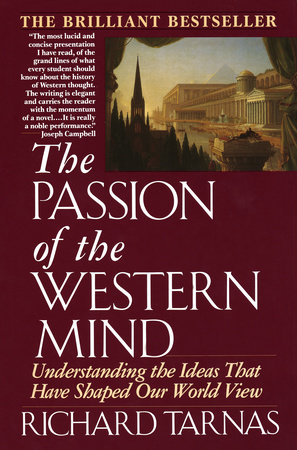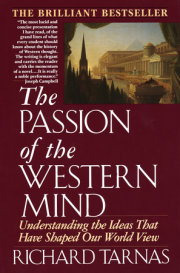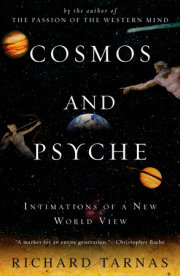The Greek World View
To approach what was distinctive in a vision as complex and protean as that of the Greeks, let us begin by examining one of its most striking characteristics—a sustained, highly diversified tendency to interpret the world in terms of archetypal principles. This tendency was in evidence throughout Greek culture from the Homeric epics onward, though it first emerged in philosophically elaborate form in the intellectual crucible of Athens between the latter part of the fifth century B.C. and the middle of the fourth. Associated with the figure of Socrates, it there received its foundational and in some respects definitive formulation in the dialogues of Plato. At its basis was a view of the cosmos as an ordered expression of certain primordial essences or transcendent first principles, variously conceived as Forms, Ideas, universals, changeless absolutes, immortal deities, divine archai, and archetypes. Although this perspective took on a number of distinct inflections, and although there were important countercurrents to this view, it would appear that not only Socrates, Plato, and Aristotle, and Pythagoras before them and Plotinus after, but indeed Homer and Hesiod, Aeschylus and Sophocles all expressed something like a common vision, reflecting a typically Greek propensity to see clarifying universals in the chaos of life.
Speaking in these broad terms, and mindful of the inexactness of such generalities, we may say that the Greek universe was ordered by a plurality of timeless essences which underlay concrete reality, giving it form and meaning. These archetypal principles included the mathematical forms of geometry and arithmetic; cosmic opposites such as light and dark, male and female, love and hate, unity and multiplicity; the forms of man (anthrōpos) and other living creatures; and the Ideas of the Good, the Beautiful, the Just, and other absolute moral and aesthetic values. In the pre-philosophical Greek mind, these archetypal principles took the form of mythic personifications such as Eros, Chaos, Heaven and Earth (Ouranos and Gaia), as well as more fully personified figures such as Zeus, Prometheus, and Aphrodite. In this perspective, every aspect of existence was patterned and permeated by such fundamentals. Despite the continuous flux of phenomena in both the outer world and inner experience, there could yet be distinguished specific immutable structures or essences, so definite and enduring they were believed to possess an independent reality of their own. It was upon this apparent immutability and independence that Plato based both his metaphysics and his theory of knowledge.
Because the archetypal perspective outlined here provides a useful point of departure for entering into the Greek world view, and because Plato was that perspective’s preeminent theoretician and apologist, whose thought would become the single most important foundation for the evolution of the Western mind, we shall begin by discussing the Platonic doctrine of Forms. In subsequent chapters, we shall pursue the historical development of the Greek vision as a whole, and thereby attend to the complex dialectic that led to Plato’s thought, and to the equally complex consequences that followed from it.
Yet to approach Plato, we must bear in mind his unsystematic, often tentative, and even ironic style of presenting his philosophy. We should bear in mind too the inevitable and no doubt often deliberate ambiguities inherent in his chosen literary mode, the dramatic dialogue. Finally, we must recall the range, variability, and growth of his thought over a period of some fifty years. With these qualifications, then, we may make a provisional attempt to set forth certain prominent ideas and principles suggested by his writings. Our tacit guide in this interpretive effort will be the Platonic tradition itself, which preserved and developed a specific philosophical perspective it regarded as originating with Plato.
Having established that pivotal position within the Greek mind, we can then move backward and forward—retrospectively to the early mythological and Presocratic traditions, and then onward to Aristotle.
The Archetypal Forms
What has been commonly understood as Platonism revolves around its cardinal doctrine, the asserted existence of the archetypal Ideas or Forms. That assertion demands a partial shift, though a profound one, from what has come to be our usual approach to reality. To understand this shift, we must first ask, “What is the precise relation between the Platonic Forms or Ideas and the empirical world of everyday reality?” Upon this question turns the entire conception. (Plato used the Greek words idea and eidos interchangeably. Idea was taken over into Latin and English, while eidos was translated into Latin as forma and into English as “form.”)
It is crucial to the Platonic understanding that these Forms are primary, while the visible objects of conventional reality are their direct derivatives. Platonic Forms are not conceptual abstractions that the human mind creates by generalizing from a class of particulars. Rather, they possess a quality of being, a degree of reality, that is superior to that of the concrete world. Platonic archetypes form the world and also stand beyond it. They manifest themselves within time and yet are timeless. They constitute the veiled essence of things.
Plato taught that what is perceived as a particular object in the world can best be understood as a concrete expression of a more fundamental Idea, an archetype which gives that object its special structure and condition. A particular thing is what it is by virtue of the Idea informing it. Something is “beautiful” to the exact extent that the archetype of Beauty is present in it. When one falls in love, it is Beauty (or Aphrodite) that one recognizes and surrenders to, the beloved object being Beauty’s instrument or vessel. The essential factor in the event is the archetype, and it is this level that carries the deepest meaning.
It could be objected that this is not the way one experiences an event of this sort. What actually attracts one is not an archetype but a specific person, or a concrete work of art, or some other beautiful object. Beauty is only an attribute of the particular, not its essence. The Platonist argues, however, that this objection rests on a limited perception of the event. It is true, he answers, that the ordinary person is not directly aware of an archetypal level, despite its reality. But Plato described how a philosopher who has observed many objects of beauty, and who has long reflected on the matter, may suddenly glimpse absolute beauty—Beauty itself, supreme, pure, eternal, and not relative to any specific person or thing. The philosopher thereby recognizes the Form or Idea that underlies all beautiful phenomena. He unveils the authentic reality behind the appearance. If something is beautiful, it is so because it “participates” in the absolute Form of Beauty.
Plato’s mentor, Socrates, had sought to know what was common to all virtuous acts, so that he could evaluate how one should govern one’s conduct in life. He reasoned that if one wishes to choose actions that are good, one must know what “good” is, apart from any specific circumstances. To evaluate one thing as “better” than another assumes the existence of an absolute good with which the two relative goods can be compared. Otherwise the word “good” would be only a word whose meaning had no stable basis in reality, and human morality would lack a secure foundation. Similarly, unless there was some absolute basis for evaluating acts as just or unjust, then every act called “just” would be a relative matter of uncertain virtue. When those who engaged in dialogue with Socrates espoused popular notions of justice and injustice, or of good and evil, he subjected these to careful analysis and showed them to be arbitrary, full of internal contradictions and without any substantial basis. Because Socrates and Plato believed that knowledge of virtue was necessary for a person to live a life of virtue, objective universal concepts of justice and goodness seemed imperative for a genuine ethics. Without such changeless constants that transcended the vagaries of human conventions and political institutions, human beings would possess no firm foundation for ascertaining true values, and would thus be subject to the dangers of an amoral relativism.
Beginning with the Socratic discussion of ethical terms and the search for absolute definitions, Plato ended with a comprehensive theory of reality. Just as man as moral agent requires the Ideas of justice and goodness to conduct his life well, so man as scientist requires other absolute Ideas to understand the world, other universals by which the chaos, flux, and variety of sensible things can be unified and made intelligible. The philosopher’s task encompasses both the moral and the scientific dimensions, and the Ideas provide a foundation for both.
It seemed evident to Plato that when many objects share a common property—as all human beings share “humanness” or as all white stones share “whiteness”—that property is not limited to a specific material instance in space and time. It is immaterial, beyond spatiotemporal limitation, and transcendent to its many instances. A particular thing may cease to be, but not the universal property that the particular thing embodied. The universal is a separate entity from the particular and, because it is beyond change and never passes away, is superior in its reality.
One of Plato’s critics once stated, “I see particular horses, but not horseness.” Plato answered, “That is because you have eyes but no intelligence.” The archetypal Horse, which gives form to all horses, is to Plato a more fundamental reality than the particular horses, which are merely specific instances of the Horse, embodiments of that Form. As such, the archetype is apparent not so much to the limited physical senses, though these can suggest and lead the way, as to the more penetrating eye of the soul, the illuminated intellect. Archetypes reveal themselves more to the inner perception than to the outer.
The Platonic perspective thus asks the philosopher to go through the particular to the universal, and beyond the appearance to the essence. It assumes not only that such insight is possible, but that it is mandatory for the attainment of true knowledge. Plato directs the philosopher’s attention away from the external and concrete, from taking things at face value, and points “deeper” and “inward,” so that one may “awaken” to a more profound level of reality. He asserts that the objects one perceives with one’s senses are actually crystallizations of more primary essences, which can be apprehended only by the active, intuitive mind.
Copyright © 2011 by Richard Tarnas. All rights reserved. No part of this excerpt may be reproduced or reprinted without permission in writing from the publisher.









